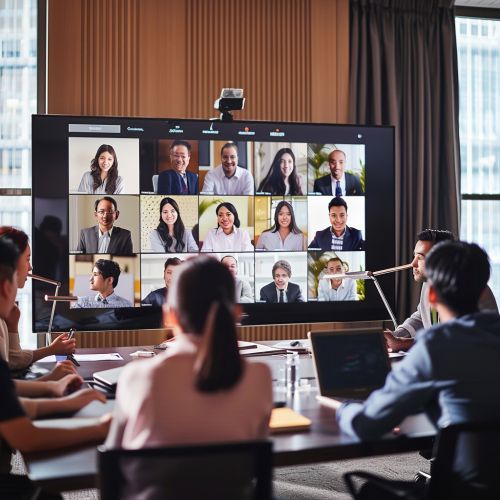Video Conferencing
Overview
Video conferencing is a technology that allows individuals or groups to meet and collaborate in real time, regardless of their geographical locations. This is achieved through the transmission of audio and video signals over the internet or other types of networks. The technology has evolved significantly since its inception, and it is now a critical component of many businesses, educational institutions, and even personal communications.
History
The concept of video conferencing can be traced back to the early days of television, with the first known demonstration of a video call taking place in 1927 between Herbert Hoover, then Secretary of Commerce, and officials at Bell Labs in New York. However, it was not until the 1960s that the first commercial video conferencing systems, such as the AT&T Picturephone, were introduced. These early systems were expensive and had limited capabilities, but they laid the groundwork for the more advanced systems that would follow.
In the 1980s and 1990s, advancements in digital technology and the advent of the internet led to significant improvements in video conferencing technology. Companies like Polycom and Cisco began to develop dedicated video conferencing equipment that offered better video quality and more features. The introduction of IP-based video conferencing in the late 1990s further improved the quality and reliability of video calls, and it also made it possible to conduct video conferences over the internet.
The 2000s saw the emergence of software-based video conferencing solutions, such as Skype and WebEx, which allowed users to make video calls from their computers without the need for dedicated hardware. These solutions were more affordable and accessible than their hardware-based counterparts, and they played a key role in popularizing video conferencing among consumers and small businesses.
In recent years, the rise of cloud-based video conferencing services, such as Zoom and Microsoft Teams, has further democratized video conferencing. These services offer high-quality video calls, a wide range of collaboration tools, and the ability to scale to accommodate large numbers of participants. They have also made it easier than ever to conduct video conferences from a variety of devices, including smartphones and tablets.


Technology
Video conferencing technology involves several key components, including video and audio capture devices, encoding and decoding algorithms, transmission protocols, and display devices.
Video and audio capture devices, such as cameras and microphones, are used to capture the video and audio signals from the participants. These signals are then encoded into a digital format using various algorithms, such as H.264 for video and AAC for audio. The encoded signals are then transmitted over a network using protocols like RTP.
On the receiving end, the signals are decoded back into video and audio signals, which are then displayed on a screen and played through speakers. The quality of the video and audio signals depends on several factors, including the quality of the capture devices, the efficiency of the encoding and decoding algorithms, the bandwidth of the network, and the quality of the display and audio playback devices.
In addition to these basic components, modern video conferencing systems also include a variety of collaboration tools, such as screen sharing, whiteboarding, and file sharing. These tools allow participants to share and interact with content in real time, making video conferences more engaging and productive.
Applications
Video conferencing is used in a wide range of settings, from business meetings and educational classes to telemedicine appointments and social gatherings.
In the business world, video conferencing is used for a variety of purposes, including team meetings, client presentations, and job interviews. It allows businesses to save time and money on travel, and it also enables them to collaborate more effectively with colleagues, clients, and partners around the world.
In education, video conferencing is used for distance learning, virtual classrooms, and online tutoring. It allows students to learn from instructors and interact with classmates who may be located in different cities, states, or even countries. It also provides opportunities for virtual field trips and collaborations with other schools.
In healthcare, video conferencing is used for telemedicine, which involves providing medical services remotely. This can include consultations, check-ups, therapy sessions, and even remote surgeries. Video conferencing can also be used for medical education and training, as well as for collaboration among healthcare professionals.
In addition to these professional applications, video conferencing is also used for personal communications. This includes social gatherings, family reunions, and even online dating. The COVID-19 pandemic has further highlighted the importance of video conferencing as a tool for maintaining social connections while practicing physical distancing.
Future Trends
The future of video conferencing is likely to be shaped by several key trends, including the continued growth of remote work, the integration of artificial intelligence (AI), and the development of virtual and augmented reality (VR/AR) technologies.
The trend towards remote work, which has been accelerated by the COVID-19 pandemic, is likely to continue in the future. This will drive further demand for video conferencing solutions, as businesses and individuals seek more effective ways to communicate and collaborate remotely.
The integration of AI into video conferencing systems could lead to a number of improvements, including better video and audio quality, more efficient bandwidth usage, and more advanced collaboration tools. AI could also be used to automate certain aspects of video conferences, such as scheduling, transcription, and translation.
The development of VR/AR technologies could lead to more immersive video conferencing experiences. For example, participants could use VR headsets to attend virtual meetings in 3D environments, or they could use AR glasses to overlay digital content onto their physical surroundings during a video call.
While these trends offer exciting possibilities, they also present challenges, such as the need for better network infrastructure, more advanced security measures, and improved accessibility. Addressing these challenges will be crucial for the continued evolution and adoption of video conferencing technology.
